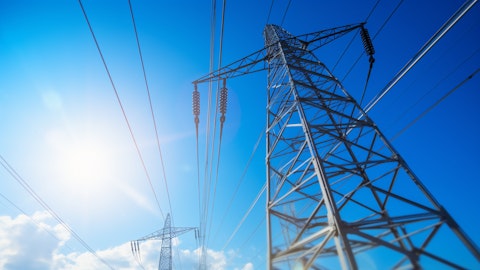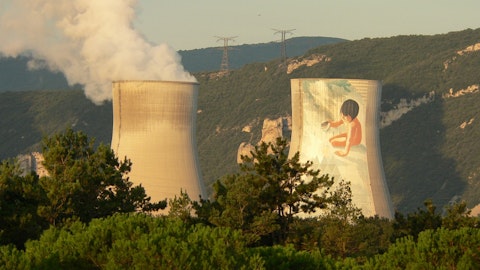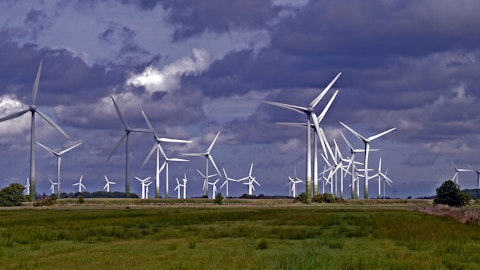Bob Blue: Yes. It will come in sort of gradually as we move closer to the end of the project. The way it worked earlier, we would lock in a contract and you might get a pretty big chunk at one time or another. From here on out, it’s some onshore transmission, it’s fuel for vessels that will be doing the offshore construction. And that’s just going to sort of come down overtime.
Diane Leopold: And the only other is miscellaneous project management cost, just our own project management through time. So those are the largest factors.
Operator: And we’ll take our last question from the line of Durgesh Chopra with Evercore ISI.
Durgesh Chopra: Two quick questions. Sorry, I just want to be absolutely clear. The — with the announced offshore sale, this is the last asset sale that we should be expecting? Or are there portfolio optimizations we should be expecting heading into the Investor Day next week?
Bob Blue: You’re correct. That’s the last one. As we signaled on the last call, the potential for an offshore wind equity partner was the last strategic step. We’ve taken that step.
Durgesh Chopra: Got it. And then just one small net, maybe this is for Steve. When we talk about the ITC accounting change and then the pension accounting change, Steve, can you just remind us what is embedded in your ’23 representative number there, EPS number there? What is kind of baked into that number?
Steven Ridge: Yes. In 2023 — you’ll see in Footnote 22 of the 10-K tomorrow, you can actually calculate it. We disclose all this. You’ll see that in 2023, we’ll have generated about $0.40 of earnings associated with pension-related income. And so going forward, we’ve talked a little bit about EROA. There’s another driver that I’ll talk just briefly about that would bring us from $0.40 closer to that average of $0.20. We — like the majority of corporate sponsors of pension plans, we calculate one of those key numbers, our expected return which like interest cost and service cost, as a component of the net income or expense for pension. We effectively smooth the actual asset returns over a 4-year period and apply our expected return on asset to that sort of smooth asset value.
And that’s not only permissible, that’s standard. Some people smooth, I think, over 5 years. We smooth over 4 years. Again, that’s pretty standard. And because of 2022’s performance, at least in our portfolio, where we experienced a very significant loss to value across, to be honest, both the equity and fixed income portions of our portfolio which, again, I don’t think is unusual for folks. What you’ll see between ’23,’24,’25 and ’26 is you see that smoothing occur such that the impact of that loss is fully recognized by 2026. Now it’s not just as simple as saying ’22 was down and I’m going to take a portion of that each year. Every year, we do that. So you effectively have the stacked Excel spreadsheet, where each year, you’re adding a little more of that — the prior year and some years are dropping off that schedule.
So it kind of it’s a net look of your asset value with this smoothing construct. Hopefully, I haven’t just confused you. But as a result of 2022’s hurt flowing through, that will be a driver. If you’re asking — if you’re at $0.40 today and you’re telling it needs to be closer to $0.20 and you’ve given us a sensitivity around 100 basis points, how would you get to the next? That’s a big driver of that remaining amount. For ITC, in 2023 as a result of the switch to deferral method, I think we’ll end up with something like $0.03 in our 2023 results. And again, what that’s from is the recast of historical results. We go back and we say, hey, if we had not accounted for this as a flow-through, if we accounted for it as deferral, some of that value is over that 30-year period.
So as I mentioned, $0.03 to $0.04 of expected operating EPS from ITC credit going forward and that’s about where we would be in 2023 as well.
Durgesh Chopra: Perfect. And Steve, just to be clear, I apologize, this is under the weeds. But — so if I’m thinking about prospective EPS, net-net, we should be — versus ’23, $2.85 [ph] in ’23, we should be $0.20 lower net-net, right, ITC being just kind of the same and the pension being $0.20 lower.
Steven Ridge: Yes, it’s not probably quite so precise. We’re using — we’re giving you $0.20 as the average over ’25 to ’29 and there is some fluctuation in that. But generically, versus 2023, $0.40 would be moving something to closer $0.20 over the ’25 to ’29 period.
Durgesh Chopra: Thank you, Steve.
Operator: Thank you. This does conclude this morning’s conference call. You may disconnect your lines and enjoy your day. Thank you.





